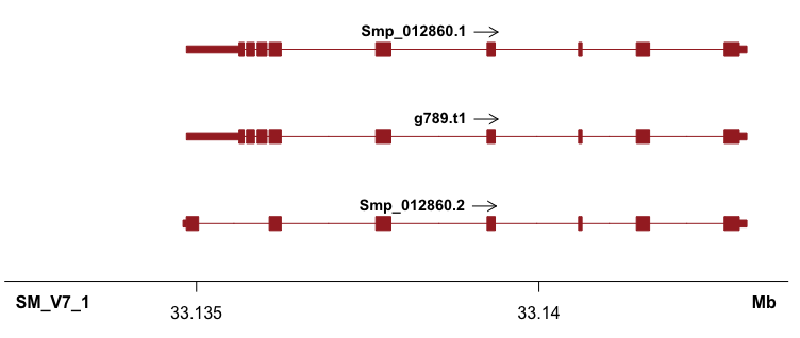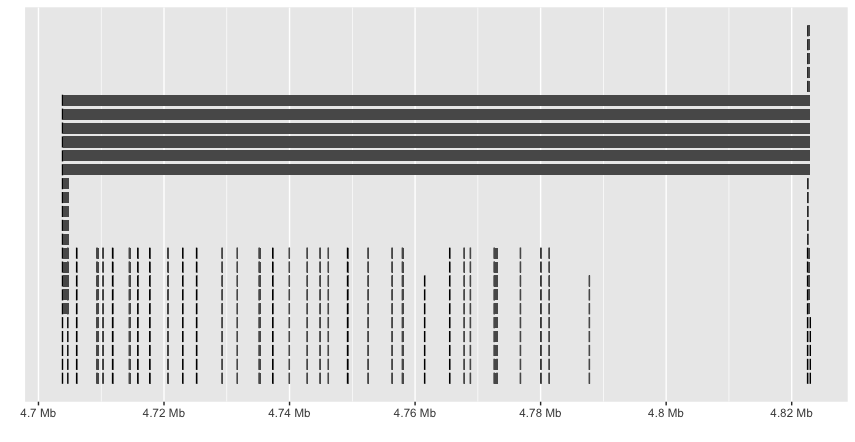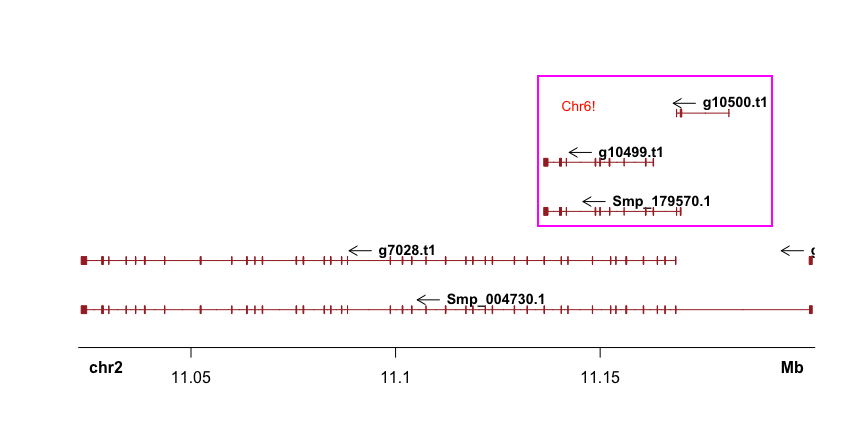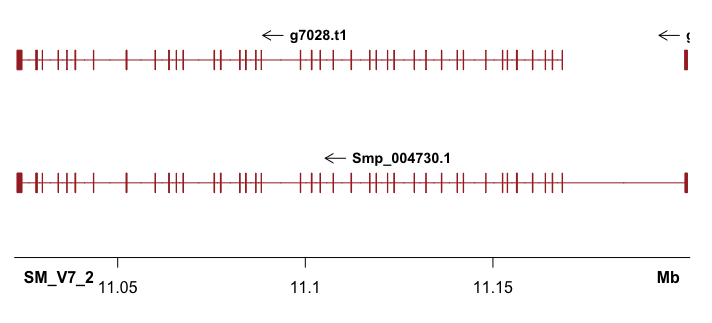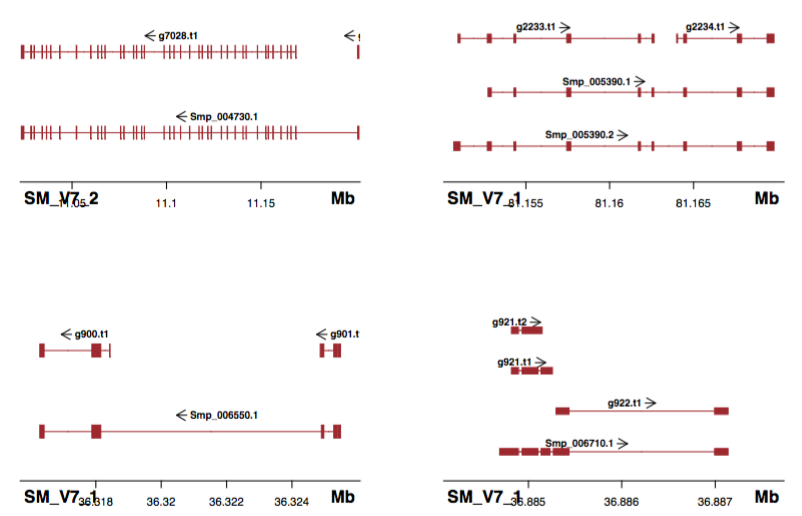I had a look at internet and there seem to be R packages for plotting genomic data: GenomeGraphs , ggbio , Sushi .
GenomeGraphs seems to take information directly from Ensembl, which is not my case. Had a try with ggbio with custome annotation (gff):
1
2
3
4
5
6
library ( ggbio )
library ( GenomicRanges )
library ( rtracklayer ) # imports gff/bed/wig
gff2 <- import ( "~/Desktop/test.gtf" ) # contains gene/mRNA/exon/CDS
rg2 <- GRanges ( "SM_V7_1" , IRanges ( 4703829 , 4812964 ))
autoplot ( gff2 , which = rg2 )
Copy ggbio doesn’t seem to recognize the hierarchy and plots everything. And the labels are missing.
ggbio2 Sushi also seems useful, especially with the plotGenes function, use the example provided:
1
2
3
4
5
6
7
8
9
10
11
12
13
library ( Sushi )
data ( Sushi_genes.bed )
chrom = "chr15"
chromstart = 72998000
chromend = 73020000
chrom_biomart = 15
plotGenes ( Sushi_genes.bed , chrom_biomart , chromstart , chromend , types = Sushi_genes.bed $ type ,
maxrows = 1 , height = 0.5 , plotgenetype = "arrow" , bentline = FALSE , col = "blue" ,
labeloffset = 1 , fontsize = 1.2 )
labelgenome ( chrom , chromstart , chromend , side = 1 , scipen = 20 , n = 3 , scale = "Mb" , line = .18 , chromline = .5 , scaleline = 0.5 )
Copy Resulted in the same figure.
The only thing is that I will need a bed file with information like:
1
2
3
4
chrom start stop gene score strand
chr15 73017309 73017438 COX5A . -1
chr15 72999672 72999836 COX5A . -1
chr15 73003042 73003164 COX5A . -1
Copy So transformed gff to bed:
1
grep Smp_322290 Sm_V7_r12.gff| grep CDS | sed 's/;/ /' | awk '{print $1 "\t" $4 "\t" $5 "\t" $10 "\t" "." "\t" $7}' | sed 's/Parent=//'
Copy
1
bdata <- read.delim ( "~/Desktop/test.bed" , sep = " " , header = T )
Copy a custome bed file:
1
2
3
4
5
6
7
8
9
10
11
12
13
14
15
16
17
18
19
20
21
22
23
24
25
26
27
28
29
30
31
32
chrom start stop gene score strand type
SM_V7_1 33135620 33135696 Smp_012860.1 . 1 CDS
SM_V7_1 33135730 33135847 Smp_012860.1 . 1 CDS
SM_V7_1 33135886 33136029 Smp_012860.1 . 1 CDS
SM_V7_1 33136062 33136237 Smp_012860.1 . 1 CDS
SM_V7_1 33137617 33137839 Smp_012860.1 . 1 CDS
SM_V7_1 33139243 33139362 Smp_012860.1 . 1 CDS
SM_V7_1 33140579 33140630 Smp_012860.1 . 1 CDS
SM_V7_1 33141423 33141616 Smp_012860.1 . 1 CDS
SM_V7_1 33142706 33142927 Smp_012860.1 . 1 CDS
SM_V7_1 33134853 33135619 Smp_012860.1 . 1 utr
SM_V7_1 33142926 33143037 Smp_012860.1 . 1 utr
SM_V7_1 33134851 33135030 Smp_012860.2 . 1 CDS
SM_V7_1 33136062 33136237 Smp_012860.2 . 1 CDS
SM_V7_1 33137617 33137839 Smp_012860.2 . 1 CDS
SM_V7_1 33139243 33139362 Smp_012860.2 . 1 CDS
SM_V7_1 33140579 33140630 Smp_012860.2 . 1 CDS
SM_V7_1 33141423 33141616 Smp_012860.2 . 1 CDS
SM_V7_1 33142706 33142927 Smp_012860.2 . 1 CDS
SM_V7_1 33134803 33134850 Smp_012860.2 . 1 utr
SM_V7_1 33142926 33143037 Smp_012860.2 . 1 utr
SM_V7_1 33135620 33135696 g789.t1 . 1 CDS
SM_V7_1 33135730 33135847 g789.t1 . 1 CDS
SM_V7_1 33135886 33136029 g789.t1 . 1 CDS
SM_V7_1 33136062 33136237 g789.t1 . 1 CDS
SM_V7_1 33137617 33137839 g789.t1 . 1 CDS
SM_V7_1 33139243 33139362 g789.t1 . 1 CDS
SM_V7_1 33140579 33140630 g789.t1 . 1 CDS
SM_V7_1 33141423 33141616 g789.t1 . 1 CDS
SM_V7_1 33142706 33142927 g789.t1 . 1 CDS
SM_V7_1 33134853 33135619 g789.t1 . 1 utr
SM_V7_1 33142926 33143037 g789.t1 . 1 utr
Copy With the following command:
1
plotGenes ( bdata , chrom = chrom , chromstart = chromstart , chromend = chromend , types = bdata $ type , maxrows = 50 , bheight = 0.08 , plotgenetype = "box" , bentline = FALSE , col = "brown" , labeloffset = .2 , fontsize = 0.9 , arrowlength = 0.025 , labeltext = TRUE )
Copy Shown in the title figure. It’s nice that the UTR (shorter than cds/exon), as well as multiple annotations can also plotted (what I need!).
It’s always good to pre-filter your annotation file as two many lines will slow down the plotting process. I have a bed file with 6400 lines and it processes quickly.
But there seems a bug that Sushi will plot genes in the start-end coordinates from all chromosomes (although you had defined “chrom”; I tried to upgrade to the latest version (1.7.1) but still not solved).
sushi-allchrom As Mike Smith pointed out on Bioconductor , it’s better to subsetting the bed file before plotting:
bed.sub <- bed[ which(bed[,"chrom"] == 6 & bed[,"start"] >= 132647962 & bed[,"end"] <= 132947962),]
plotGenes(bed.sub)
But this will also cause an error:
1
2
Error in FUN(X[[i]], ...) :
only defined on a data frame with all numeric variables
Copy Have to save bed.sub to a new file and read it into R, then everything fine:
1
2
3
4
5
bed.sub <- bed [which ( bed[ , "chrom" ] == chr & bed[ , "start" ] >= chrstart & bed[ , "end" ] <= chrend ), ]
write.table ( bed.sub , file = "~/Desktop/subbed" , quote = F , row.names = F )
subbed <- read.delim ( "~/Desktop/subbed" , sep = " " , header = T )
plotGenes ( subbed , chr , chrstart , chrend , types = subbed $ type , maxrows = 50 , bheight = 0.08 , plotgenetype = "box" , bentline = FALSE , col = "brown" , labeloffset = .2 , fontsize = 0.9 , arrowlength = 0.025 , labeltext = TRUE )
labelgenome ( chrom , chromstart , chromend , side = 1 , scipen = 20 , n = 3 , scale = "Mb" , line = .18 , chromline = .5 , scaleline = 0.5 )
Copy
sushi-region Then can apply a for loop to plot all regions of interest
sushi-batch
